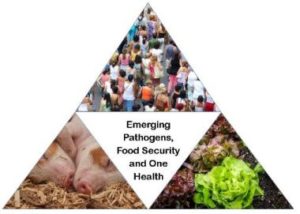
One Health is a vast concept and there are differing definitions of what One Health encompasses. The US CDC describes it as:
“One Health is an approach that recognizes that the health of people is closely connected to the health of animals and our shared environment…Successful public health interventions require the cooperation of human, animal, and environmental health partners. ”.
The One Health Commission defines it as:
“a collaborative, multisectoral, and trans-disciplinary approach – working at local, regional, national, and global levels – to achieve optimal health and well-being outcomes recognizing the interconnections between people, animals, plants and their shared environment.”
Whilst the definitions may vary, the themes of working together and collaboration are central to all versions of the concept. In this day and age, internet communication means that we have the ability to collaborate with groups all over the world, but how do you find people you could collaborate with on One Health related studies, especially if they are not part of the same discipline as you? This is particularly difficult if your potential collaborator is not a researcher. I have worked in journal publishing for over ten years and can see the potential role that journals can play with encouraging collaboration.
A scientific journal is not just a store for published papers (that may get read a handful of times) but can be a platform for bringing together papers on common themes (through collections and Special Issues) and making your work ‘discoverable’ through different publishing models and offering avenues that are available alongside the ‘traditional journal’.
 Michael Schloter (Helmholtz Center for Environmental Health) is co-Editing an ambitious Special Issue in the transformative journal Microbial Ecology called Emerging Pathogens, Food Security and One Health inviting papers from any discipline and encouraging interdisciplinary collaboration (current and future) to find solutions to global health issues.
Michael Schloter (Helmholtz Center for Environmental Health) is co-Editing an ambitious Special Issue in the transformative journal Microbial Ecology called Emerging Pathogens, Food Security and One Health inviting papers from any discipline and encouraging interdisciplinary collaboration (current and future) to find solutions to global health issues.
Michael says of the One Health concept:
The “One Health” concept describes the interlink between environment and human health. It is based on the observation that many common diseases are a result of negative impacts from disturbed environments. This includes allergies, infectious diseases, but also cancer and diabetes. The interaction of environmental- and human microbiomes plays a key role in this concept, focusing first on antibiotic resistant and pathogenic microbiota, but acknowledging nowadays also the importance of a highly diverse environmental microbiome as trigger for our immune system.
The One Health concept induced a rethinking also in medicine, implementing a more systemic view for disease development. So more and more, beyond the development of new therapies for sick people, prevention of diseases becomes a major topic. This includes measures for environmental protection and restoration of sites with a negative human foot like urban or industrial areas.
As you can see from the last sentence, the emphasis is on thinking beyond traditional health sciences and encouraging collaboration with the social scientists, people working in and promoting environmental remediation, civil services departments… and this is just one example.
Michael’s Special Issue is inviting new submissions at the moment, but even if your recent paper has been published already, it is not too late to include them in collections (at no added cost). Publishers create collections (many are cross-journal) on trending or emerging themes, so look out for them in marketing emails or on journal homepages. One such collaborative collection that I have personally created is Contribution of climate change to the spread of infectious diseases, which brings together already published open access papers from sixteen journals. Papers are then brought to the attention of readers from completely different journals through these collections.
 Another way that journals can play an important role in promoting collaboration is through improved discoverability. Of course, making your research Open Access is a significant way to achieve this, as many interested and potential collaborators may not have access to journals. Publishing datasets and making them openly available is a not so obvious, but still useful approach to promoting discoverability (datasets can be published on their own or along with a research paper) and encouraging collaboration by enabling someone else to build on the information already available – the Missing Maps project operates on this basis. Ruth Timme and her colleagues explain how genomic data can be optimized and shared to support One Health approaches.
Another way that journals can play an important role in promoting collaboration is through improved discoverability. Of course, making your research Open Access is a significant way to achieve this, as many interested and potential collaborators may not have access to journals. Publishing datasets and making them openly available is a not so obvious, but still useful approach to promoting discoverability (datasets can be published on their own or along with a research paper) and encouraging collaboration by enabling someone else to build on the information already available – the Missing Maps project operates on this basis. Ruth Timme and her colleagues explain how genomic data can be optimized and shared to support One Health approaches.
 Scientific papers are not the easiest to read and digest. They follow a prescribed language format and are not accessible to people outside that scientific discipline. Blogs allows for a relaxed and informal way of communicating complex scientific concepts – BugBitten being an excellent example of this. What you may not realize is that publishers often host blog platforms that are free – and importantly they are keen for you to use them to talk about your work. BugBitten receives between 20 to 30,000 visitors (academic and non-academic) per month, making it a great way to promote your work to potential collaborators. BugBitten is part of the wider BMC Blog network and Nature portfolio hosts communities sites– all of these blogs are available to authors too. Just contact your journal’s editorial office or publishing editor to find out how you can use their blogs.
Scientific papers are not the easiest to read and digest. They follow a prescribed language format and are not accessible to people outside that scientific discipline. Blogs allows for a relaxed and informal way of communicating complex scientific concepts – BugBitten being an excellent example of this. What you may not realize is that publishers often host blog platforms that are free – and importantly they are keen for you to use them to talk about your work. BugBitten receives between 20 to 30,000 visitors (academic and non-academic) per month, making it a great way to promote your work to potential collaborators. BugBitten is part of the wider BMC Blog network and Nature portfolio hosts communities sites– all of these blogs are available to authors too. Just contact your journal’s editorial office or publishing editor to find out how you can use their blogs.
There are many avenues for promoting collaboration and journals offer some options for this. I hope through this article you are encouraged to try some of them.

Comments